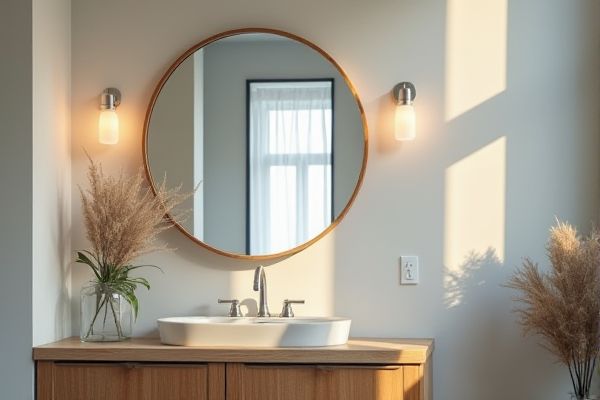
An anti-fog mirror uses a special coating or heating element to prevent condensation, ensuring clear visibility even in steamy environments, whereas a regular mirror often fogs up and obscures your reflection. Discover which mirror best suits your needs and how it can improve your daily routine by reading the full article.
Table of Comparison
| Feature | Anti-fog Mirror | Regular Mirror |
|---|---|---|
| Fog Resistance | Yes, resists fog buildup | No, fog accumulates quickly |
| Technology | Heated surface or hydrophilic coating | Standard glass or acrylic surface |
| Usage | Ideal for bathrooms, vehicles, and humid environments | Suitable for general use in low humidity |
| Cost | Higher price due to advanced features | Lower, budget-friendly option |
| Maintenance | Requires standard cleaning; coatings durable | Standard cleaning; prone to water spots |
| Durability | Enhanced durability with specialized coatings | Standard durability |
Introduction to Anti-Fog Mirrors vs Regular Mirrors
Anti-fog mirrors utilize advanced hydrophilic coatings or heating elements to prevent condensation buildup, ensuring clear visibility in humid environments, unlike regular mirrors that often fog up and obscure reflection. These specialized mirrors are ideal for bathrooms, fitness centers, and vehicles where moisture presence is high. Your choice between anti-fog and regular mirrors impacts daily convenience and safety in fog-prone settings.
How Anti-Fog Mirrors Work
Anti-fog mirrors incorporate a heating element or anti-condensation coating that prevents moisture buildup, maintaining clear visibility even in humid or steamy environments. Unlike regular mirrors, which fog up quickly due to temperature differences causing water droplets to form on the surface, anti-fog mirrors regulate surface temperature to keep condensation from forming. You can enjoy uninterrupted reflection clarity in your bathroom or car with this advanced technology.
Features of Regular Mirrors
Regular mirrors feature a reflective glass surface backed by a metallic coating, commonly silver or aluminum, providing clear, high-quality reflections. They are susceptible to fogging due to condensation when exposed to humid environments, which can obscure your view. Unlike anti-fog mirrors, regular mirrors do not have built-in heating elements or special coatings to prevent moisture buildup.
Key Differences Between Anti-Fog and Regular Mirrors
Anti-fog mirrors feature a specialized coating or built-in heating element that prevents condensation buildup, ensuring clear visibility in humid or steamy environments, unlike regular mirrors which tend to fog up in such conditions. These mirrors maintain consistent clarity without the need for constant wiping, enhancing safety and convenience in bathrooms or vehicles. Regular mirrors, while often more affordable, lack moisture-resistant properties, making them less practical for use in high-humidity settings.
Benefits of Using Anti-Fog Mirrors
Anti-fog mirrors provide clear and uninterrupted visibility by preventing condensation buildup, which is a common issue with regular mirrors in humid or steamy environments. This feature enhances safety and convenience, especially in bathrooms or vehicles, where fogging can obscure your view. Your daily routine becomes smoother and more efficient with the consistent clarity that anti-fog technology ensures.
Common Uses for Regular Mirrors
Regular mirrors are widely used in bathrooms, bedrooms, and dressing rooms for everyday grooming and personal care. They serve essential functions in interior design to enhance room lighting and create the illusion of space. Common applications also include decorative purposes and use in vehicles for rearview and side-view monitoring.
Installation and Maintenance Comparison
Anti-fog mirrors require a slightly more involved installation process involving a power source or adhesive heating elements to activate the fog-resistant feature, unlike regular mirrors which only need standard mounting hardware. Maintenance of anti-fog mirrors typically involves occasional cleaning with non-abrasive solutions and ensuring the heating element remains functional, whereas regular mirrors demand only routine cleaning to prevent smudges and water spots. Over time, anti-fog mirrors may need component checks or replacement, while regular mirrors generally do not require additional upkeep beyond surface cleaning.
Cost Analysis: Anti-Fog vs Regular Mirrors
Anti-fog mirrors typically cost 30% to 50% more than regular mirrors due to integrated heating elements or special coatings that prevent condensation. Regular mirrors, while more affordable upfront, may incur indirect costs related to frequent cleaning or replacement in humid environments. Investing in anti-fog mirrors can reduce maintenance expenses and enhance usability in bathrooms or vehicle interiors where fogging is common.
Longevity and Durability Factors
Anti-fog mirrors feature specialized coatings or heating elements that enhance longevity by preventing moisture buildup, which can degrade surface quality over time. Regular mirrors lack these protective layers, making them more susceptible to fogging, corrosion, and eventual deterioration in high-humidity environments. Materials used in anti-fog mirrors, such as tempered glass and hydrophobic coatings, contribute significantly to their increased durability compared to standard mirrors.
Which Mirror Type Is Right for You?
Choosing between an anti-fog mirror and a regular mirror depends on your environment and needs; anti-fog mirrors are ideal for bathrooms or spaces with high humidity because they prevent condensation, ensuring clear visibility even after hot showers. Regular mirrors may be sufficient for dry, well-ventilated areas where fogging is not a concern and typically cost less. If you value consistent clarity without extra maintenance, an anti-fog mirror can enhance your daily routine and improve your experience.
 homyna.com
homyna.com